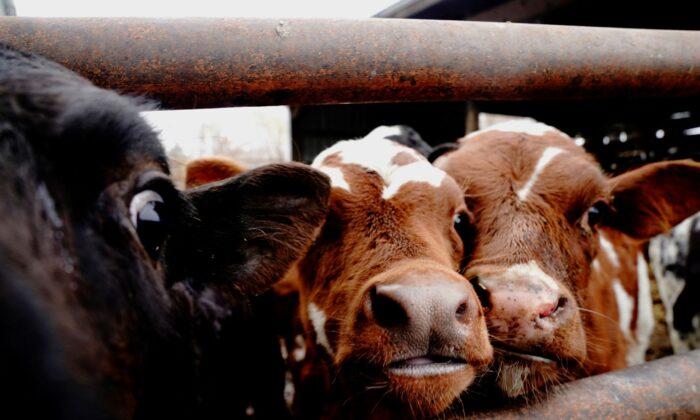Farmers across the U.S. upper Midwest are being forced to dump their supplies of excess milk as facilities struggle to find space to store it as demand wanes, according to multiple reports.
Demand for milk across the upper Midwest is down 20 percent this year, according to NewsNation. However, farmers still need to milk cows regularly, otherwise they risk leaving the animals with bruising, udder injuries, or serious sickness.
That has left farmers battling with an excess stock of milk that simply has nowhere to go.
Pete Hardin, the editor of Wisconsin-based dairy publication The Milkweed, told local television station WITI earlier this month that the excess milk could fill 45–50 trailer loads a day, at around 6,000–7,000 gallons each.
“This is a crisis. I mean, dairy is Wisconsin’s single largest agricultural endeavor,” said Mr. Hardin. The state saw more than 400 dairy farms shut down last year. “The industry has been sort of punched in the nose and stunned,” he said.
The issue is also affecting farmers’ earnings, according to Mr. Hardin, who noted that milk prices are already 40 percent lower than they were a year ago.
“Farmers’ cash flow gets squeezed,” he said, adding that some farmers may be forced to send more dairy cows to slaughter.
Milk Consumption on the Decline
A spokesperson confirmed to the publication that the milk was treated before being dumped in order to comply with environmental regulations, but stopped short of providing the exact amount of milk that was flushed away.However, they added that the amount of fresh milk being disposed of had recently declined to five truckloads per week, which the publication reports is around 6,500 gallons.
The issue of excess milk production is not concentrated solely in Wisconsin either, according to Laurie Fischer, the founder and chief executive officer of American Dairy Coalition.
“We know that milk is being dumped in other parts of the Midwest, not just Wisconsin,” Mr. Fischer told Bloomberg. “At the same time, farms are making decisions as milk prices fall to their lowest levels since the worst period of the pandemic.”
At the height of the pandemic in 2020, an estimated 2.7–3.7 million gallons of milk were being dumped by farmers in the United States every day amid waning demand, according to the Dairy Farmers of America, in part due to lockdown restrictions that shut down restaurants and schools.
In 2021, milk consumption worsened further, according to the U.S. Department of Agriculture, reaching an all-time low of around 16 gallons per person, down from about 29 gallons in 1975.
Part of the declining demand is being driven by Generation Z amid a growing transition to plant-based alternatives among that age group who appear to be more health conscious, according to experts.
In 2022, that age group purchased 20 percent less milk than the national average, according to the consumer market research company Circana.

Staffing Issues, Milk Prices Falling
The Biden administration’s efforts to reduce methane emissions from dairy systems are creating further issues for dairy farmers.However, the latest declining demand comes at a time when milk production is at a record high, totaling 19 billion pounds, and up 0.8 percent from May 2022, according to reports, meaning that supply is seriously outpacing demand.
Meanwhile, the prices of milk and cheese products are on the decline, adding further woes for farmers, who are now earning around 30–40 percent less than they did last year, according to Chuck Nicholson, an agricultural economist at the University of Wisconsin-Madison.
“We had some really tremendous milk prices last year that gave dairy farmers a message, ‘Hey, we need more milk in the marketplace,’” Mr. Nicholson told Wisconsin Public Radio. “Producers are pretty good at responding to those kinds of incentives. So now we’re bringing that additional milk online compared to last year. And so that’s part of why we are seeing the issues.”
Overproduction isn’t the only issue plaguing the dairy industry; a shortage of workers at dairy processing plants is also worsening the issue.
“There are a lot of plants who used to be open and running seven days a week, or six days a week, and they’ve had to cut down their days of operation,” Sarah Sarbacker, communications director for FarmFirst Dairy Cooperative in Madison, Wisconsin, told Wisconsin Public Radio. “They don’t have the staff to run their plants as much as they used to. So for every day that they’re not open, that’s a whole day of them not taking in loads of milk.”
The United States saw 6 percent of its dairy farms shut down last year, which is on trend with a similar figure to the year prior.
As the costs of farming have soared amid increasing inflation and demand appears to have stalled, many farmers are left with no option but to make adjustments.
“I expect the herd size and milk production to decline in the coming months as farmers make adjustments due to the low prices,” Lucas Fuess, a senior dairy analyst with Rabobank, told Bloomberg.





